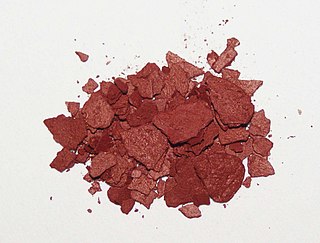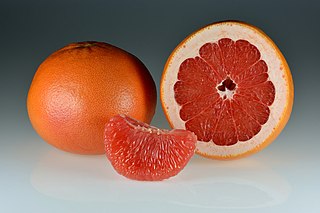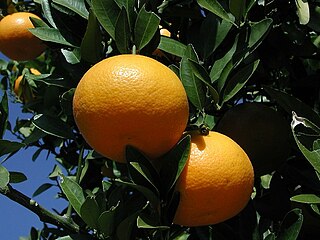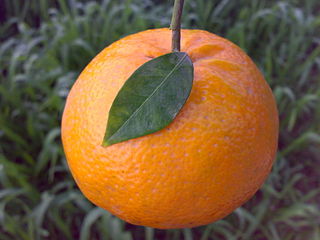
Lycopene is an organic compound classified as a tetraterpene and a carotene. Lycopene is a bright red carotenoid hydrocarbon found in tomatoes and other red fruits and vegetables.

A mango is an edible stone fruit produced by the tropical tree Mangifera indica. It originated from the region between northwestern Myanmar, Bangladesh, and northeastern India. M. indica has been cultivated in South and Southeast Asia since ancient times resulting in two types of modern mango cultivars: the "Indian type" and the "Southeast Asian type". Other species in the genus Mangifera also produce edible fruits that are also called "mangoes", the majority of which are found in the Malesian ecoregion.

The papaya, papaw, or pawpaw is the plant species Carica papaya, one of the 21 accepted species in the genus Carica of the family Caricaceae, and also the name of its fruit. It was first domesticated in Mesoamerica, within modern-day southern Mexico and Central America. It is grown in several countries in regions with a tropical climate. In 2022, India produced 38% of the world's supply of papayas.

The grapefruit is a subtropical citrus tree known for its relatively large, sour to semi-sweet, somewhat bitter fruit. The flesh of the fruit is segmented and varies in color from pale yellow to dark red.

A clementine is a tangor, a citrus fruit hybrid between a willowleaf mandarin orange and a sweet orange, named in honor of Clément Rodier, a French missionary who first discovered and propagated the cultivar in Algeria. The exterior is a deep orange colour with a smooth, glossy appearance. Clementines can be separated into 7 to 14 segments. Similar to tangerines, they tend to be easy to peel. They are typically juicy and sweet, with less acid than oranges. Their oils, like other citrus fruits, contain mostly limonene as well as myrcene, linalool, α-pinene and many complex aromatics.

The navel orange is a variety of orange with a characteristic second fruit at the apex, which protrudes slightly like a human navel. This variety first was caused by a mutation in an orange tree, and first appeared in the early 19th century at a monastery in Bahia, Brazil. The mutation caused the orange to develop a second fruit at its base, opposite the stem, embedded within the peel of the primary orange. This mutation also caused it to be seedless, meaning the only way the plant can be propagated is by cutting and grafting.

Citrus unshiu is a semi-seedless and easy-peeling citrus species, also known as the satsuma mandarin or Japanese mandarin. During the Edo period of Japan, kishu mikans were more popular because there was a popular superstition that eating Citrus unshiu without seeds made people prone to infertility. Citrus unshiu became popular in Japan after modernization started in the Meiji period. It was introduced to the West from the Satsuma region of Japan in 1878.

California Citrus State Historic Park is an open-air museum in the city of Riverside, California, United States. As part of the state park system of California, it interprets the historic cultural landscape of the citrus industry. The park’s museum exhibits and interpretive features share the story of the citrus industry's role in the history and development of Southern California, and is told through the experiences of the diverse migrant and immigrant groups who made it all possible. The 248-acre (100 ha) park was established in 1993.

The Jaffa orange, is an orange variety with few seeds and a tough skin that makes it particularly suitable for export.

The blood orange is a variety of orange with crimson, near blood-colored flesh. It is one of the sweet orange varieties. It is also known as the raspberry orange.

The tangor is a citrus fruit hybrid of the mandarin orange and the sweet orange. The name "tangor" is a formation from the "tang" of tangerine and the "or" of "orange." Also called the temple orange, its thick rind is easy to peel and its bright orange pulp is sour-sweet and full-flavoured.

The iyokan, also known as anadomikan (穴門みかん) and Gokaku no Iyokan, is a Japanese citrus fruit, similar in appearance to a mandarin orange, with Dancy as the pollen parent and Kaikokan as the seed parent. It is the second most widely produced citrus fruit in Japan after the satsuma mandarin. Ehime Prefecture accounted for 90% of Iyokan production in 2021.

The Valencia orange is a sweet orange cultivar named after the famed oranges in Valencia, Spain. It was first hybridized by pioneer American agronomist and land developer William Wolfskill in the mid-19th century on his farm in Santa Ana, southern California, United States, North America.

The orange, also called sweet orange to distinguish it from the bitter orange, is the fruit of a tree in the family Rutaceae. Botanically, this is the hybrid Citrus × sinensis, between the pomelo and the mandarin orange. The chloroplast genome, and therefore the maternal line, is that of pomelo. There are many related hybrids including of mandarins and sweet orange. The sweet orange has had its full genome sequenced.

The Kinnow is a high yield mandarin hybrid cultivated extensively in the wider Punjab region of India and Pakistan.

Eliza Tibbets was among early American settlers and founders of Riverside, California; she was an activist in Washington, D.C., for progressive social causes, including freedmen's rights and universal suffrage before going to the West Coast. A spiritualist, she led seances in Riverside. She became known for successfully growing the first two hybrid Washington navel orange trees in California.
Riverside, California, was founded in 1870, and named for its location beside the Santa Ana River. It became the county seat when Riverside County, California, was established in 1893.

Reikou is a cultivar of tangor. It is a citrus hybrid of a hybrid of Kiyomi and Encore and Murcott tangor.

Citrus taxonomy is the botanical classification of the species, varieties, cultivars, and graft hybrids within the genus Citrus and related genera, found in cultivation and in the wild.

The Parent Washington Navel Orange Tree is a tree grown by Eliza Tibbets in Riverside, California, in 1873. The Riverside County tree was designated a California Historic Landmark (No.20) on June 1, 1932, at the corner of Magnolia Street and Arlington Street, Riverside. The Bahia, Brazil, Washington navel orange was brought to the United States by the U.S. Department of Agriculture in 1870. The Department of Agriculture imported twelve trees; from these trees, some buds were grafted on to California sweet orange trees. The Washington Navel Orange is also called California Navel Orange.




















